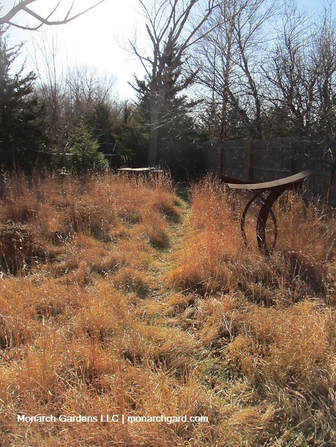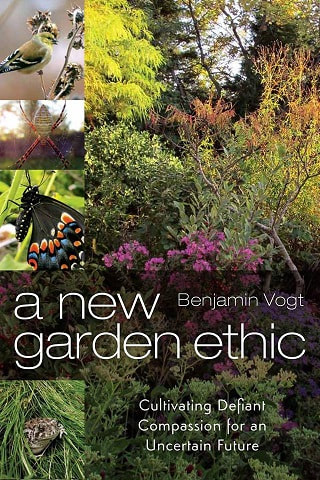After sending a plant list to the local weed superintendent, he was gracious enough to meet at my home to discuss the issue. Here's how it went, what we both learned, and what you need to take away as we move to more sustainable wildlife landscapes in urban areas.
----------------
At first we were both in our ideological corners. I was being quoted ordinance about vermin, snakes, and fire, while I was quoting stats about snakes eating mice, native bee decline, and the low burn temperature and quick burn time of prairie grasses. I planned to approach our talk as calmly as possible, but after pacing for a solid hour beforehand I'd worked myself up. So, the first lesson is don't pace for an hour beforehand.
But after awhile we settled into a very productive and friendly half-hour conversation I was thankful for. We taught each other and, I believe, pledged to work together here and around town. One of the largest sticking points centered on cutting down plant material in fall so as not to be a fire hazard. Since every garden I design is planned to be aesthetically pleasing in winter -- not to mention a haven for birds and overwintering insects -- I kept coming back to how we needed to find a solution to have the garden standing. Heck, in spring I leave 12-18" of stubble for nesting bees. Eventually, I heard "hey, if no one complains in winter I won't come knocking on your door."
It was a wonderful, energizing conversation and I felt like there was room for future collaboration, especially as we noted some struggling public spaces around town that had recently been planted but were filling up with weeds. The super also asked me what I tell people at my talks about designing a space all species can be comfortable with, and I'll tell you what we agreed on and what I say everywhere I can:
1) It can help to hire a professional to get you started. That can be a landscape plan, a consult, or a coach that keeps coming back to help you progress. You can install a design yourself or have the professional do it for you then modify on your own, but having good bones is critical -- especially in front yards (my backyard has a wood fence and faces acres of dense red cedars, but I still got in trouble).
2) Plant in masses and groups and tiers. These are traditional design strategies that we're all accustomed to, and so they help folks see that a landscape has intention. Grouping plants also serves as a larger beacon for pollinators flying overhead, so design with 3, 5, or 7 of a kind. Have tall plants in the back or middle with shorter plants toward the front. Don't just toss out a bag of seed or let the lawn go to see what comes up. Convert the space quickly or do it one piece at a time over years.
4) Have a mowed edge around beds that abut sidewalks, driveways, or property lines. In lieu or combination with that strategy is placing low plants along the edges. For example, I have nothing that gets taller than 2 feet within 4-6 feet of the sidewalk. Hey, people don't like to be touched by plants they don't know.
5) Have a sign that says what you are doing and why. The super mentioned signs significantly mitigate their workload. Something as simple as "This is a low-maintenance, native plant pollinator garden."
7) Native plant pollinator gardens don't have to look like meadows. They can be more simple and modern looking, or formal and angular. There is a middle way, too, a place where we can all meet in the landscape.
8) Talk to your neighbors. Tell them what you're doing. Invite them over for drinks. Knock on doors and calmly / warmly ask if they'd like to talk about it or see it. Don't accuse anyone of anything or act like you're better then them. Educate. Teach. Welcome. Even if you're a passionate activist who believes the sixth mass extinction is here and our over-manicured lawns are creating an ethical crisis that will consume us all (ahem), hold back and just listen. We can still have constructive and friendly conversations regardless of what is modeled for us online and in the news.
And here are more specific tips on making weediness appear garden like and acceptable.
If you're interested in the above ideas, A New Garden Ethic is a superb place to start. Then, explore the suggested book list in the back for even more guidance and encouragement on design, native plant benefits, ecosystem gardening with science, and environmental philosophy.
As Natural Landscaping Takes Root We Must Weed Out Bad Laws (25 years old, so there is surely more legal precedent to find)
Weed Laws and Ordinances (lots of links)
Sourcebook of Natural Landscaping for Local Officials (incredible treasure trove of why, how, and where)
It's amazing to me that we've been struggling with the same issue for decades now -- even when "natural" garden design was once the default landscape mode long before lawns came into vogue just after mid century. But what we see is what we accept, and what we see is what we assume is good. The prevalence of highly-managed lawn, and wood mulch as a design aesthetic in its own right, is harming a push toward sustainable design -- we need more public examples of what we can do, even if those examples require more intensive management to withstand scrutiny.
One final note -- the super said it's important for folks to know landscapes like mine are also high maintenance like lawn. I'm not sure. I mow the back meadow in spring and am done. The front 400 foot garden and the older 1,500 foot main garden I simply use a hedge trimmer on and leave the detritus as natural mulch (another ordinance no no, even if it's what more and more large public gardens do). Obviously, if you try to take on more than you can chew from the outset then you can get overwhelmed, give up, and let the weeds come in. But for me, I honestly spend one day a year in spring doing the majority of my work. With tight-knit plant communities (layers of plants on 12 inch centers or closer), my big job is cataloging wildlife and observing plant growth -- with the occasional yanking of a tree seedling, musk thistle, or bush honeysuckle.
--------
Learn more!
1) 200 free articles on sustainable design for wildlife plus native plant profiles.
2) Online classes from gardening for climate change to how to start a native plant garden.









 RSS Feed
RSS Feed

